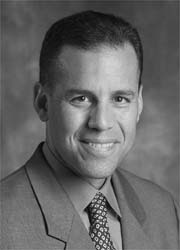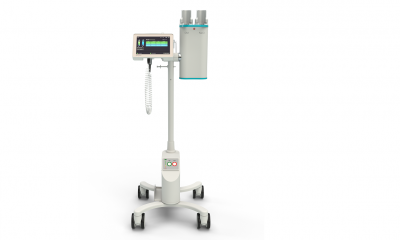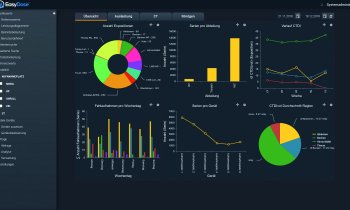Kodak: committed to a digital future
Dan Kerpelman, President of Eastman Kodak Company's Health Imaging Group, discussed film versus digital solutions, PACS and Kodak's goals in diagnostic imaging, with Daniela Zimmermann of European Hospital
Dan Kerpelman: Kodak's Health Imaging Group is one of Kodak's three business groups, which include photography, commercial imaging and a components business.

Health Imaging’s revenues in 2002 totalled $2.3 billion. Our portfolio is divided into several areas. Film capture and output is our traditional x-ray film and processing business. Then we have digital capture, specifically in projection radiography, such as Computed Radiography and Digital Radiography. The third is healthcare information solutions: PACS, RIS etc.
We also have digital output, which comprises our laser imagers that print medical images. Finally we have a major services business, which include traditional equipment repair and maintenance as well as professional services. Those include consulting, systems integration, systems management, financing - not as a bank, but when financing is an important part of providing a solution, this is something we can offer. Those are the product areas and we operate in five world regions.
Daniela Zimmermann: We have talked about PACS, RIS and EPR for years, but all we see is small solutions in small niche areas, not a holistic approach to integrating healthcare.
DK: I agree with your observation of the industry, which has been characterised by two extremes. The small niche players, as you call them, didn’t exist 12-24 months ago and perhaps will not exist in 12-24 months time. They arrive with a very specific expertise - often with very nice features purely in terms of software comparison, but not necessarily as a holistic coverage, with the ability to understand healthcare processes sufficiently to evolve according to its needs.
At the other extreme are the big providers - the large modality companies.
DZ: Big, yes. But they still offer the complete solution they’d like.
DK: Well, that’s my view - I’m glad you said it first. They have broader regional solutions than perhaps the small niche players, but in a somewhat rigid way. I’ve heard customers say that, as healthcare providers dealing with the large firms, there is a feeling that ‘... if this solution doesn’t solve our problem, then you must have the wrong problem’. We prefer to position Kodak between those extremes, and we are big enough to provide continuity.
Indeed, Kodak has been in the x-ray-business almost since the time that Roentgen discovered the x-ray 120 years ago. And we certainly plan to be here for the next 100+ years. Over the decades, we have grown significantly from a film-oriented business to what we have today: a well-rounded portfolio that makes us a leader in digital imaging, while maintaining our leadership in film. With this broad scope, we have the advantage of size, and can make big investments, when necessary. For example, several months back we decided to commit to healthcare information technology (IT) in a far bigger way. We’re not a giant, but can be a flexible player, recognising that healthcare IT, for instance, is still a field with very specific, local requirements, such as billing and coding, public versus private healthcare, reinvestments, insurance, large hospitals versus small imaging centres, publicly versus privately managed healthcare centres. Our size and flexibility, and commitment is recognised by our customers.
DZ: Big film companies still thrive, and seem to waver about investing in the digital field...
DK: That’s a fair criticism of film manufacturers overall. But, speaking for Kodak, things have changed very dramatically. For example, Kodak was very aggressive about recruiting me, because I come from the IT world, not from a media or film company. Looking at the evolution of our R&D investments as well as the alliances we are working on now, you can see that we have a long-term strategy in the digital area. We definitely will not be a company that is in and out of digital imaging and IT, and that’s not just about profit. It’s about the future and about leading digital transformation.
As indicated earlier, we have a broad digital portfolio that includes PACS as well as digital capture with computed and digital radiography. Our portfolio also includes digital output, such as laser imaging, which had been a neglected invention in our list, but is now one of the biggest parts of the Kodak portfolio. PACS, RIS and EPR are really at the core of our portfolio. These are critical control products that dictate how those other devices provide service and are part of the much-needed holistic solution.
To be successful in PACS is not about selling hardware or software packages. We have evolved a service model. We have a technology and innovation centre, in Genova, Italy, with a very intelligent team who understands healthcare, clinical issues, workflow, image, therapy etc, and they have a very deep knowledge of the technology for PACS and other systems. Typically, they start with a consultation with a customer - there are no invoices or costs - they just work side by side to developed plans to suite customers’ needs.
At the technology centre, we can simulate how products like PACS and RIS will integrate with an existing hospital infrastructure, that is, if a hospital has already decided about RIS or archiving technologies, our experts will solve interoperability challenges (I believe that any individual component of healthcare IT, or imaging, will become very compatible one day). Then, before installation, users come for training and test-driving - like when buying a car. Customers can also visit actual sites where our equipment has been installed to see how it performs in ‘real-life’ situations. These sites include Stavanger, Norway, Hammersmith, London, or Delft, Holland - one of the biggest PACS installations worldwide.
Some people think of Kodak only as an American company - but we are very European. We engineer and manufacture in Europe. In Chalon-sur-Saône, France, we manufacture 40 million square metres of X-ray film annually. That’s one of our biggest manufacturing facilities, and the biggest employer in Burgundy. We also engineer and manufacture our RIS system in Reykjavik. Our film-finishing factory is in Berlin, and we have a dental enterprise in Stuttgart.
More than 1,600 hundred of our employees, about a third of the total workforce, are in Europe, and about a third of our business is generated here. So while our roots are in America, we also consider ourselves to be a European company.
30.04.2003











